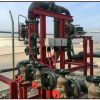Proportioning of Mechanical Dose Foam Makers
Proportioning of mechanical dose foam makers : The fourth generation of mechanical dosing foam fitters
**

**
The fourth generation of mechanical dosing foam fitters
Fire Foam Proportioner is a key piece of equipment in foam fire extinguishing systems. The main task of the firefighting foam proportioner is to accurately adjust and calculate the ratio of foam to water in order to produce a foam with the correct properties and quality and be effective in extinguishing the fire.
Water and foam proportioning devices have NFPA11:2021 types according to a different standard, which in this article will explain the functioning of mechanical dosing foam round water proportioning devices and their types.
**

**
Definitions of order to proportionality
Foam concentrate: Foam concentrate is a thickening foam agent that is received from the manufacturer.
Foam solution: a homogeneous mixture of water and foam concentrate in the suitable proportion.
Foam: It is a stable accumulation of small bubbles with a density lower than oil or water, which is sticky and insists on covering the horizontal surface. The fire extinguishing floor flows freely over the surface of the burning liquid and forms a solid, airless and continuous cover and prevents the access of fugitive vapors to the air. A good floor resists destruction by wind, heat, and flame, and in case of mechanical destruction, it can be restored.
Proportioner: a device for proportional mixing of foam concentrate and water, with the desired percentage rate of foam concentrate injection.
**
Proportioning of foam concentrate
Proportioning of foam is the process of mixing or combining two or more components with special proportions and forming a desirable floor. Different types of proportional systems have advantages or strengths as well as specific limitations. It is important that the proportioning system is able to consistently maintain the correct ratio of foam concentrate to supply water throughout the entire proportioning range required by the system.
**
Proportionation methods
-Premixed method
– Compression rationing
– Balanced pressure adjustment
– Balanced inline pressure adjustment
– Adaptation of the jet pump
– Venturi method
**
– Proportioning around the pump
**
 Balder tank fitter
Balder tank fitter
****
 Proportionate instruments with venture
Proportionate instruments with venture
**
 Digital proportioner with two flowmeters
Digital proportioner with two flowmeters
**

Digital Proportioner with a Flowmeter
**
Round water fitting (round mechanical foam)
The basis of the work of these proportioners is to have a water circulation motor in the fire water path, which rotates according to the water flow in a certain circle and transfers its torque to the positive displacement pump. This positive displacement pump has the task of suctioning foam from atmospheric tanks and injecting it into the fire line, with a higher pressure and specific mixing ratio.
The figure below shows the components of this proportional system in the NFPA11:2021 standard.
**

**
Advantages of round water fitting devices (mechanical dosage foam)
This type of fitting system has the following disadvantages
1- No need for external energy and electricity
2- No need to set the device
3- The possibility of working in a certain range of water flow
4- Easy installation
**

**
These proportional instruments are produced in four generations in the world:
1. The first generation, more than 25 years ago, the first type of these systems was introduced in the world and currently they are produced and supplied by various manufacturers in the world.
This proportioner has a water-circulating motor of the double blade type made of polymer material, which is encapsulated into a positive displacement pump, of the piston type. Among the problems of this generation, we can point out the breaking of the water motor blades, vibration and high noise, as well as the problems of using piston pumps, such as sensitivity to high viscosity and the impossibility of working in dry and oily conditions. Also, due to the moisture absorption of the polymers used in the water motor blades and the increase in volume in some samples, there was a possibility of the blades locking in the body in high temperature conditions.
**

**
2. In the second generation, the blades of the water motor were fivefold and gear pumps were used instead of pistons. With this method, the vibrations were very limited and the major problems of using piston pumps were solved, but the breaking of polymer trays was still considered as the Achilles heel of this generation.
**

**
3. In the third generation, the water motor is from the type of tabe to the type of timing metal lobe, which is coupled to the positive displacement back pump of the piston type. By changing the type of water motor, the possibility of breaking the blades was completely eliminated.
**

**
4. In the last generation, water monitors are of the type of timing metal lobes that are coupled to a gear pump. In addition to the fact that this generation does not have the problem of breaking the polymer blades of the first and second generations, it benefits from the advantages of the second generation gear pumps, and currently they are the least defective proportioners of their kind.
**

Schematic view of a fourth generation dosing foam system
**
 Cutaway view of the 4th generation water engine
Cutaway view of the 4th generation water engine
**
 Break-resistant metal lobes
Break-resistant metal lobes
**
 Fluid analysis of fourth generation engine water
Fluid analysis of fourth generation engine water
**
**
**





